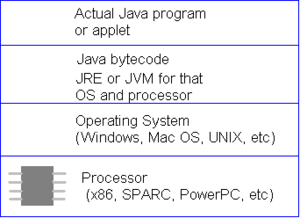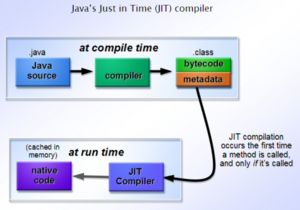Java platform
The Java platform is a bundle of interdependent programs required to create and run programs using the Java programming language. Sun began work on the platform in 1992 and formally launched the programming language in 1995, after which its use grew rapidly across the computer industry. There are three different editions of the Java platform:[1]
- Java Standard Edition, called Java SE[2] (formerly J2SE) for desktop machines
- the Java Enterprise Edition, called Java EE[3] (formerly J2EE) for web servers; a superset of the SE
- the Java Micro Edition, called Java ME[4] (formerly J2ME) for hand-held devices such as smart phones.
As of December 2006, the Java platform (Standard Edition) was in its 6th major revision (version 6.0).
How the platform works
The Java platform's centerpiece is an execution engine, also known as the virtual machine or runtime environment, that has been implemented for most operating systems, including Windows, Linux, Unix and Mac OS X. As well, thousands of pre-written Java library classes, also called base classes, are available on each operating system. The Java runtime environment (JRE) and the Java class libraries make all computers look alike so that programs written in the Java programming language can run identically on all of them.
The platform consists of multiple programs, each of which provides a distinct portion of its overall capabilities. The essential components in the platform are the Java source code compiler, the Java class libraries, and the Java runtime environment. The Java source code compiler converts Java source code (files with an extension of .java) into Java bytecode (files with an extension of .class). The runtime environment is a special program that takes as input Java intermediate bytecode (.class files) for execution according to the rules laid out in the JavaTM Virtual Machine Specification, Second Edition[5].
The Java platform does not necessarily include an integrated development environment (IDE), although there is a Java runtime environment bundle available from Sun that includes the free NetBeans IDE. Several other free IDE's exist, including the widely used, free Eclipse IDE (which is open-source and can be used for several other languages besides Java).
Bytecode and JIT compilation
Java bytecode is an intermediate language; Java bytecode programs are loaded and run by a Java Virtual Machine (JVM), also known as a Java Runtime Environment (JRE). JREs tend to be sophisticated; most of them implement the JVM specification by means of a just-in-time (JIT) compiler that, at runtime, converts intermediate bytecode into native machine code. JIT compilation occurs on a per method basis only the first time each method is called, after which the native code for that method remains cached in memory; this means that subsequent executions of that method run as fast as native programs. Java programs tend to "warm up" after they have been executing for awhile, and in some cases they execute as efficiently as native code after an initial startup period.
The Java platform also includes extensive libraries (pre-compiled into Java bytecode) containing reusable code, as well as numerous ways for Java applications to be deployed, including being embedded in a web page as an applet, on a desktop machine for a single user, on a web server as a servlet (returning "dynamic" information to web browsers), or on a web server as a web service endpoint (procedure callable across a network from any kind of platform). There are several other components as well.
Downloads
When downloading Java, users must select their current operating system, and then choose either the Java Runtime Edition (JRE) or Java Development Kit (JDK) version. The JRE contains only the runtime (virtual machine) and pre-compiled libraries; this is all that is needed to run Java programs on a given operating system. The JDK also contains the Java source code compiler and other utilities needed by programmers when developing Java programs.
Versions
- 1.0 - Released in 1996, the original version had quite a few deficiencies.
- 1.1 - Released in 1997, version 1.1 was greatly revised and improved.
- 1.2 - From 1998, known as version 2, it included Swing (for graphical user interfaces)
- 1.3 - From 2000, version 3 had no new syntax but introduced new libraries.
- 1.4 - From 2002, version 4 introduced the Java assert statement.
- 5.0 - In 2004, Java 5 introduced quite a bit of new syntax, including generics. This version adheres to the Java Language Specification, 3rd Edition[6].
- 6.0 - Introduced in 2006.
Associated file extensions
- Java source files have an extension of .java
- Java bytecode files (also called class files) have an extension of .class
- Java executable programs have an extension of .jar (Java ARchive); they must be loaded at runtime by a Java Runtime Environement (JRE)
- .jar files may contain byte codes, resources such as images, metadata, and they may even contain source code
- To view and separate the contents of a .jar file, make a copy of it and rename the copy to have a .zip extension. Then open it like any .zip file.
- when people say "component" or library, they usually mean a .jar file that does not have an entry point--it has methods that we can call, but it doesn't run "standalone"
- Enterprise Java (on a web server) uses two additional file archive extensions: .war and .ear . A .war file can be used to install a web application into a servlet container (a Java Virtual Machine, or runtime, that collaborates with a web server). An .ear file is used to install and encapsulate Enterprise Java Beans.
Competition with C# and the .NET platform
In 2000, Microsoft introduced the .NET Framework, a new platform with a Java-like language (C#) and associated development tools. The Java platform and the .NET framework have been competing vigorously on the desktop, but especially in the area of server technology. Many software developers (programmers) become expert on one or the other, but few have time to learn both. The schism of understanding the two platforms has been widened due to misinformation and disinformation, with a fair amount of zealotry on the part of each system's defenders.
From a historical viewpoint, the two systems may be seen as having different goals. A primary goal for Java was to enable a program to run on several different operating systems; this was accomplished by providing implementations of the Java virtual machine for all prevalent operating systems, including members of the Unix family, Linux, Max OS X and most versions of Windows.
Microsoft has been widely criticized for only implementing its .NET runtime "only on Windows." Such criticism does not take into account that Windows is not a single operating system (at least not from the viewpoint of a programmer who must call routines in the operating system). Even before Microsoft Vista appeared in 2007, there were already approximately 35 versions of Windows, all with slightly different application programming interfaces (API's). The difficulty of developing software for these many different Windows systems had led to a situation called "DLL Hell", where the wrong versions of dynamic link libraries (DLL's) were encountered by programs trying to run. Creating the .NET framework solved this huge problem for Microsoft by making all versions of Windows alike to programmers.
In fact, some .NET programs can run on non-Windows platforms. Miguel de Icaza (co-creator of GNOME) has created an open source implementation of the .NET framework for Unix-like operating systems; it runs on Mac OS X, Linux and Sun's Solaris). Called Mono, this independent implementation of a "common language runtime" is based on .NET's ECMA/ISO standards[7] and is not under the jurisdiction or ownership of Microsoft.
The .NET framework and the Java platform have diverged in various other ways, including that .NET was designed to allow many different programming languages to use its runtime and libraries (whereas the Java platform was not used fpr multiple languages until very recently). There was no theoretical reason for Java being the only language that initially used the Java runtime. It was only since perhaps 2006, in response to Microsoft's multi-language .NET strategy, that Sun finally began a push to get additional languages "targeting" the Java runtime.
Platform comparison
- Java was the model
for Microsoft when it created C# in 2002
- Java and C# code look very similar; it is fairly easy to switch between the two
- Java is cross-platform; .NET is cross-language:
- Java provides freedom from all OS differences, by making necessary cross-platform compromises; Java does not provide cross-language calling
- .NET makes 36 versions of Windows alike for programmers; it eliminates the "DLL hell" which formerly occurred when installing Windows applications
- .NET libraries can be used by any of the .NET compiled languages (of which there are dozens); libraries can be written in any .NET language
- the two platforms compete fiercely in the world wide web
- JSP's require Apache web servers (Linux or Unix); these are HTML interlaced with code
- called "servlets" if all code
- ASP's require Microsoft's IIS6 web server; these are HTML interlaced with code
- called "web handlers" if all code
- both Linux and Microsoft web servers use load-balancing across mirrored web farms to scale up
- so-called "dynamic" languages such as Ruby are seen by some as the next stage beyond Java and .NET
- it's an arms race!
References
- ↑ Open-Source Java Project Overview. Retrieved on 2007-04-08.
- ↑ "Java SE at a Glance" Copyright 1994-2007 Sun Microsystems, Inc.publisher=Sun (2007). Retrieved on 2007-09-22.
- ↑ "Java EE at a Glance" Copyright 1994-2007 Sun Microsystems, Inc.publisher=Sun (2007). Retrieved on 2007-09-22.
- ↑ "Java ME at a Glance" Copyright 1994-2007 Sun Microsystems, Inc.publisher=Sun (2007). Retrieved on 2007-09-22.
- ↑ "The Java Virtual Machine Specification, Second Edition" Copyright © 1997-1999 Sun Microsystems, Inc. 901 San Antonio Road, Palo Alto, California 94303 U.S.A. All Rights Reserved.. Sun Microsystems, Inc. (1999). Retrieved on 2007-08-24.
- ↑ "The Java Language Specification, Third Edition" Copyright © 1996-2005 Sun Microsystems, Inc.4150 Network Circle, Santa Clara, California 95054 U.S.A.All rights reserved.. Sun Microsystems, Inc. (2005). Retrieved on 2007-08-24.
- ↑ "Mono Project Main page" (Retrieved 2007-04-25).

